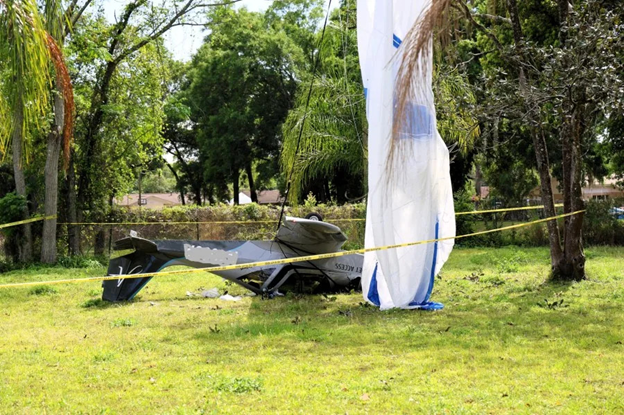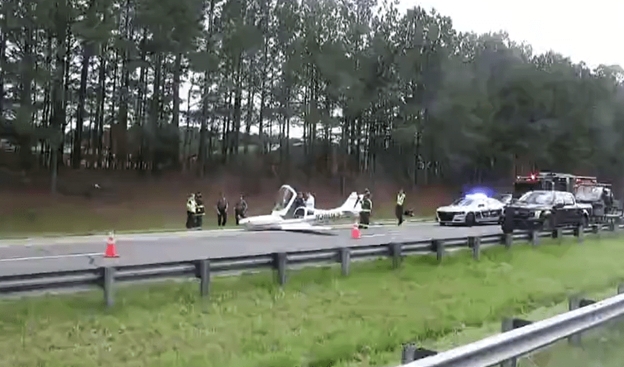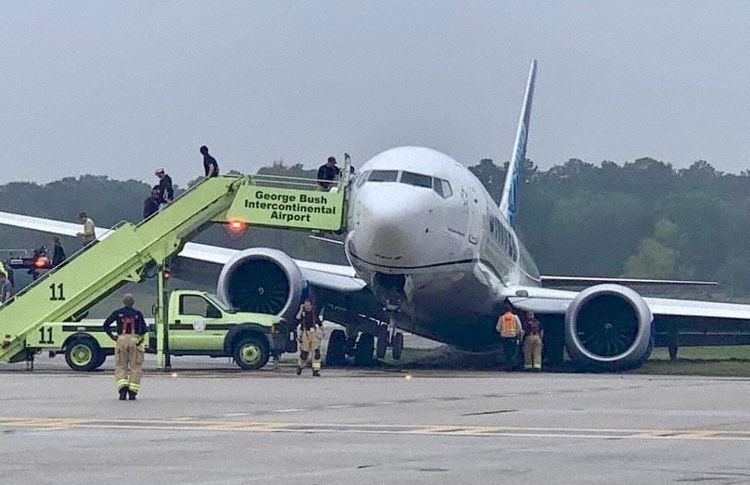Published on:
Friday the 5th of April, 2024
Video shows plane fall from sky in Hillsborough County, 2 taken to trauma center
Garrett Phillips
TAMPA, Fla. (WFLA) — Hillsborough County Fire Rescue is on the scene of a small plane crash in Seffner on Thursday at around 3:25 p.m.
Fire rescue said the plane is an approximately 15-foot small plane that crashed with parachute deployment and landed upside-down in a yard off Parsons Ave at Forrest Circle.
Crews said two adults were found walking around, with no hazards involving the plane. They were taken to a local trauma center in stable condition.
The flight took off from Tampa Executive Airport at 3:16 p.m. and was last seen five minutes later, according to Flight Aware. This was the planes third flight of the day.
The incident has been turned over to the Hillsborough County Sheriff’s Office.
https://news.yahoo.com/small-plane-crashes-hillsborough-county-194841978.html


Small plane makes emergency landing on US-1 in Chatham County, NCSHP confirms
by: Chloe Rafferty, Hannah Leyva
MONCURE, N.C. (WNCN) — UPDATE: On Friday morning, the Federal Aviation Administration said the aircraft, a single-engine Lancair 360 with the registration number N360XS, landed on a highway near the Raleigh Executive Jetport around 4:20 p.m. Thursday after experiencing engine problems.
The airport is in Sanford, but near the Chatham County line.
The FAA said the pilot was the only person on board and the agency is investigating the incident.
Previous story:
The North Carolina State Highway Patrol has confirmed that a small plane made an emergency landing in Chatham County on Thursday afternoon.
According to NCSHP, the single-engine aircraft landed on U.S. 1 northbound at about 3:30 p.m. near Exit 81 towards Pea Ridge Road and Moncure.
They said there were no injuries.
According to flight plans, the plane was headed to Ocean Isle Beach after taking off from Lynchburg, Virginia at about 3 p.m.
At this time, it is unclear if the plane hit anything on the way down.
NCSHP said the plane was still on the highway Thursday night and is expected to remain there until Friday morning.
According to NCDOT, the shoulder is closed where the plane is located and is expected to reopen at 9 a.m. Friday.

United B38M at Houston on Mar 8th 2024, runway excursion and main gear collapse
By Simon Hradecky, created Friday, Mar 8th 2024 16:36Z, last updated Friday, Apr 5th 2024 10:02Z
A United Boeing 737-8 MAX, registration N27290 performing flight UA-2477 from Memphis,TN to Houston Intercontinental,TX (USA) with 160 passengers and 6 crew, landed on Houston's runway 27 and slowed to taxi speed (about 30 knots) prior to attempting to turn right off onto the last taxiway, however, skidded and went straight after turning about 45 degrees and came to a stop on soft ground off the runway at 07:58L (13:58Z) with the left main gear collapsed.
A passenger reported the aircraft had landed normally and in normal attitude, when the crew attempted to turn off the aircraft was too fast, skidded, the gear collapsed and the aircraft went off onto soft ground. The passenger disembarked onto the runway via stairs.
The FAA stated: "After landing at George Bush Intercontinental Airport in Houston, United Airlines Flight 2477 rolled onto the grass when exiting onto the taxiway around 8 a.m. local time on Friday, March 8. The passengers deplaned on the taxiway and were bused to the terminal. The Boeing 737 departed from Memphis International Airport. Please contact the airline for additional information. The FAA will investigate. "
The NTSB announced they have dispatched an investigation team to Houston to investigate the runway excursion of a United Boeing 737 at Houston's Intercontinental Airport.
On Apr 5th 2024 the NTSB released their preliminary report summarizing the sequence of events:
According to the flight crew, the captain (61, ATPL, 15,191 hours total, 9,607 hours on type) was the pilot flying and the first officer (FO) (38, ATPL, 1,252 hours on type) was the pilot monitoring. The captain said he observed the reported runway surface condition codes when checking the automatic terminal information system (ATIS) via his electronic flight bag (EFB). For runway 26L and 26R, he recalled seeing codes of 3/3/3 and for runway 27 codes of 5/5/5. The actual runway surface condition codes being broadcasted on the ATIS for runway 27 at the time were 3/3/3 which according to the runway condition assessment matrix (RCAM) indicated the runway was slippery when wet and “braking deceleration is noticeably reduced for the wheel braking effort applied or directional control is noticeably reduced.”
When the crew checked in with Houston Approach Control, they were told to expect a landing on runway 26L. The captain asked the FO to request a landing on runway 27 instead. The FO made, and the controller approved the request and issued instructions for the instrument landing system (ILS) approach to runway 27. After checking in with Houston Tower (about 12,000 feet msl according to the FO), the captain asked the FO to request approval to roll to the end of runway 27. The FO made the request. A tower controller approved it and instructed them, “keep your speed up”. The captain changed the autobrake setting from 2 to 1 (which would command a reduced deceleration rate). The approach was conducted in instrument meteorological conditions (IMC) and, according to the crew, the airplane broke out of the clouds between 800 and 1,000 feet msl. They reported that visibility under the clouds was good, and the captain recalled that the runway appeared dry. The FO recalled that the runway appeared wet.
The crew stated that the touchdown was uneventful, at an appropriate speed, and within the touchdown zone. The speed brakes extended normally, and the thrust reversers were deployed to idle reverse thrust. The captain said that, shortly after touchdown, he retracted the speedbrakes by the action of moving the speedbrake lever to its down and locked position, which disabled the autobrakes. He did not “slow too much initially” because the runway appeared dry, he wanted to expedite their time on the runway, and because he preferred decelerating gradually for passenger comfort.
The captain said he applied the brakes manually using the toe brakes at about 6,000 feet from the end of the runway but felt as if the deceleration was less than normal. DFDR data and automatic dependent surveillance-broadcast (ADS-B) data indicated that after the disabling of the autobrakes occurred, manual braking did not begin until the airplane was about 4,000 feet from the end of the runway. The captain recalled hearing the runway awareness and advisory system (RAAS) alert indicating 1,000 ft of runway distance remaining. He became concerned and began applying more pressure to the brakes. As he approached the end of the runway, he elected to attempt to turn onto taxiway SC, by utilizing the steering tiller and rudder pedals while pushing aggressively on the brake pedals.
During the turn onto the taxiway, he felt the fuselage and rudder/brake pedals begin to shake violently. He briefly released the brake pressure and the shaking ceased. He then reapplied aggressive brake pressure and the shaking resumed. The airplane slid off the runway and the left MLG tires and nose wheels tires entered the grass before the airplane came to a rest with its left wing low.
A postaccident examination of the accident site revealed that the left MLG tires had impacted a large concrete “manhole” designed as an electrical junction box for lights/utilities at the airport. As a result of the impact, the left MLG separated from the airplane at the fuse pins near the rear spar as designed to prevent more severe damage to surrounding structures. The airplane came to rest on the left engine nacelle, left winglet, and aft fuselage and sustained substantial damage to the left wing and aft fuselage.
Data from the DFDR was sent to the NTSB’s Vehicle Recorder Laboratory in Washington, DC, for analysis. A preliminary review of data has been completed and a plot showing the braking parameters is shown in figure 3. Data showed that at touchdown the speed brake lever position [Speed Brake Lever Pos] and auto brake parameters were full up and on for about 5 seconds before transitioning to down and locked and off for the remainder of the landing rollout.
The engine thrust reversers were deployed for the left and right engines for about 27 and 26 seconds respectively at idle reverse. The left and right brake pressure increased to their maximum pressure consistent with aggressive manual braking before and as the airplane’s heading changed consistent with a right turn.
Certified ADS-B data, which records more accurate latitude and longitude data than the DFDR, was provided to the NTSB by the FAA. Analysis of the ADS-B and DFDR data shows that the airplane touched down about 1,000 feet from the runway threshold with a groundspeed of about 158 knots. With about 1,000 ft and 500 ft of runway remaining the airplane groundspeeds were about 72 kts and 57 kts respectively. The right turn to exit the runway was initiated at about 39 kts groundspeed and the aircraft departed the end of the paved surface at about 22 kts.
Related NOTAM:
!IAH 03/099 IAH RWY 09/27 CLSD 2403081532-2403231300
Metars:
KIAH 081453Z 16005KT 1 1/2SM BR BKN008 OVC020 23/22 A2972 RMK AO2 SLP063 60002 T02280222 51014=
KIAH 081353Z 19005KT 1 1/2SM BR BKN008 OVC018 23/22 A2971 RMK AO2 SFC VIS 2 1/2 SLP059 T02280217=
KIAH 081311Z 17004KT 2 1/2SM BR BKN008 OVC015 23/22 A2970 RMK AO2 T02280217=
KIAH 081253Z 17003KT 2 1/2SM BR BKN010 BKN021 OVC030 22/22 A2970 RMK AO2 SFC VIS 4 RAE30 SLP056 P0002 T02220217=
KIAH 081246Z 17003KT 2 1/2SM BR BKN010 BKN021 OVC030 22/22 A2969 RMK AO2 SFC VIS 4 RAE30 P0002 T02220217=
KIAH 081153Z 14003KT 2 1/2SM -RA BR OVC008 22/22 A2968 RMK AO2 SFC VIS 4 RAE1058B14 SLP049 P0004 60004 70006 T02220217 10228 20211 53001 $=
KIAH 081053Z 00000KT 7SM -RA BKN006 OVC011 23/22 A2966 RMK AO2 RAB48 SLP044 P0000 T02280217 $=
KIAH 080953Z 16008KT 7SM BKN007 OVC012 22/21 A2967 RMK AO2 SLP046 T02220211 $=
https://flightaware.com/live/flight/UAL2477/history/20240308/1240Z/KMEM/KIAH


NTSB Prelim: Denzil Velarde MTO Sport
Pilot Noted That The Gyroplane Was Unable To Maintain Sufficient Airspeed And Altitude
Location: Tavernier, FL Accident Number: ERA24LA153
Date & Time: March 24, 2024, 14:10 Local Registration: N291AG
Aircraft: Denzil Velarde MTO Sport Injuries: 2 Minor
Flight Conducted Under: Part 91: General aviation - Personal
On March 24, 2024, about 1410 eastern daylight time, an experimental, amateur-built MTO Sport, N291AG, was substantially damaged when it was involved in an accident near Tavernier, Florida. The pilot and passenger sustained minor injuries. The gyroplane was operated as a Title 14 Code of Federal Regulations Part 91 personal flight.
The pilot stated that he performed an engine run-up with no anomalies noted. About six minutes after engine start up, shortly after takeoff, the pilot noted that the gyroplane was unable to maintain sufficient airspeed and altitude. With little runway remaining, the pilot turned the gyroplane left to “land like a helicopter” on a side road; however, the wind blew the gyroplane backward and the tail section impacted a concrete fence. The gyroplane flipped onto its side and sustained substantial damage to the empennage. The pilot initially reported to a Federal Aviation Administration inspector that there were “no issues with the engine power; he just did not have enough airspeed at liftoff and the wind might have shifted to a tail wind.”
Subsequently, the pilot stated that he believed that engine stopped producing power shortly after takeoff.
The gyroplane was retained for further examination.
FMI: www.ntsb.gov

Today in History
33 Years ago today: On 5 April 1991 an Atlantic Southeast Embraer 120 Brasilia crashed near Brunswick, GA, U.S.A. following a loss of control, killing all 23 occupants.
Time: 14:51
Type: Embraer EMB-120RT Brasilia
Owner/operator: Delta Connection
Registration: N270AS
MSN: 120218
Year of manufacture: 1990
Total airframe hrs: 816 hours
Cycles: 845 flights
Engine model: Pratt & Whitney Canada PW118
Fatalities: Fatalities: 23 / Occupants: 23
Aircraft damage: Destroyed, written off
Category: Accident
Location: 3 km W of Brunswick-Glynco Jetport, GA (BQK) - United States of America
Phase: Approach
Nature: Passenger - Scheduled
Departure airport: Atlanta-William B. Hartsfield International Airport, GA (ATL/KATL)
Destination airport: Brunswick-Glynco Jetport, GA (BQK/KBQK)
Investigating agency: NTSB
Confidence Rating: Accident investigation report completed and information captured
Narrative:
Atlantic Southeast Flight 2311 was scheduled initially for Embraer EMB-120RT Brasilia N228AS to depart at 13:24 EST. Because of mechanical problems an airplane change was made to N270AS. The flight departed Atlanta at 13:47 and arrived in the Brunswick area about 14:44. At 14:48 the flight was cleared for a visual approach to runway 07. The Embraer had just turned from base leg to final approach when the aircraft was seen to pitch up about 5 degrees and roll to the left until the wings were vertical. The airplane then nosed down into the ground, 9975 feet short of the runway.
The left propeller blade angle at the time of impact was about 3 degrees, which is below the range for normal flight. The right propeller blade angle was above the flight idle low pitch stop.
It was determined that the left propeller actuator did not respond to a PCU action to increase blade angle because the PCU quill spline teeth were severely worn and could not engage the transfer tube spline. The extreme and rapid wear of the nitrided quill spline teeth was the result of the sliding contact with the titanium nitrided surface of the transfer tube spline.
This harder titanium-nitrided coating on the transfer tube was selected by the manufacturer, Hamilton Standard, to improve manufacturing efficiency compared to the originally certificated nitrided transfer tube.
PROBABLE CAUSE: "The loss of control in flight as a result of a malfunction of the left engine propeller control unit which allowed the propeller blade angles to go below the flight idle position. Contributing to the accident was the deficient design of the propeller control unit by Hamilton Standard and the approval of the design by the Federal Aviation Administration. The design did not correctly evaluate the failure mode that occurred during this flight, which resulted in an uncommanded and uncorrectable movement of the blades of the airplane's left propeller below the flight idle position."

Mailing Address
Subscribe to our newsletter
Contact Us
We will get back to you as soon as possible.
Please try again later.
